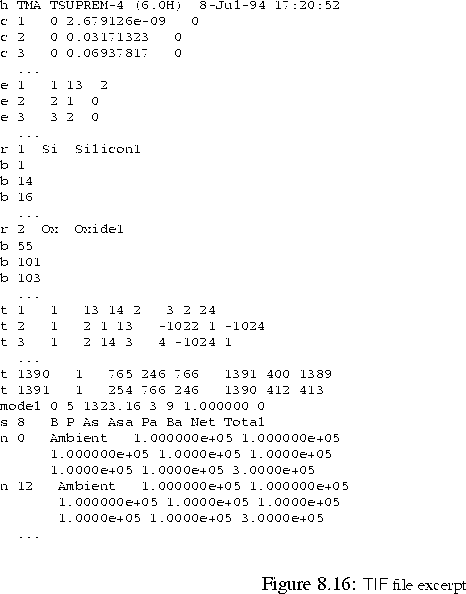




This MOSFET example was initially available as a TIF file see Section 3.1.1 with a size of 172 kB, which was translated using the TIF wrapper in VISTA into a PBF file. An excerpt of the TIF file is shown in Fig. 8.16. A short header states the program which wrote, and the time and date when the file has been written. The c (coordinate) key then defines nodal coordinates with index, x and y coordinates and a mesh spacing parameter which is always zero in this case. Material regions and interfaces are defined through the e (edge) key followed by the edge index, the first and second point index and a boundary code. The r (region) key is then used to define the simulation regions (a silicon and an oxide region in this case), where the following b (boundary) keys reference the edges making up the region. A mesh is defined using the t (triangle) key with index, node indices and neighboring triangle indices. The model key defines the model with which the following solution function s was derived. The n (node) key then specifies for each node or triangle the respective values of the solution functions defined with the s key.

Note that although the TIF file is able to define multiple regions (a
silicon and a silicon dioxide region in this case) by specifying their
bounding edges, there can be just one grid in the whole TIF file,
and all attributes have to be defined on this only grid. Since the
VISTA wafer state defines that each segment has to have its own grid, and
all respective attributes have therefore be defined upon this grid, the TIF
wrapper splits this grid into two grids matching the two segments in this
case. Likewise the eight different attributes are split and defined on the
corresponding grids. Additionally, the PIF wrapper includes the original
TIF grid and defines the TIF-specific mesh spacing information as an
attribute on this grid.
in the whole TIF file,
and all attributes have to be defined on this only grid. Since the
VISTA wafer state defines that each segment has to have its own grid, and
all respective attributes have therefore be defined upon this grid, the TIF
wrapper splits this grid into two grids matching the two segments in this
case. Likewise the eight different attributes are split and defined on the
corresponding grids. Additionally, the PIF wrapper includes the original
TIF grid and defines the TIF-specific mesh spacing information as an
attribute on this grid.
To make the sizes of the TIF file and the PBF file comparable, this additional information was removed, and the PIF file translated to a PBF file with the PIF binary file manager. The resulting PBF file has a size of 188 kB. This slight difference is due to the symbol tables and PIL search structures incorporated in the PLB, and due to the now two grids and 16 attributes contained in the PBF file, but also accounts to the way the triangular grid is promoted to the PIF file. Removing grid information from both files and comparing the sizes again yields 118 kB for the TIF file, whereas the PBF file has only 76 kB. This small size is favourably achieved by the compression layer of the PIF application interface, which effectively compresses the large double precision attribute values and point list coordinate arrays.



